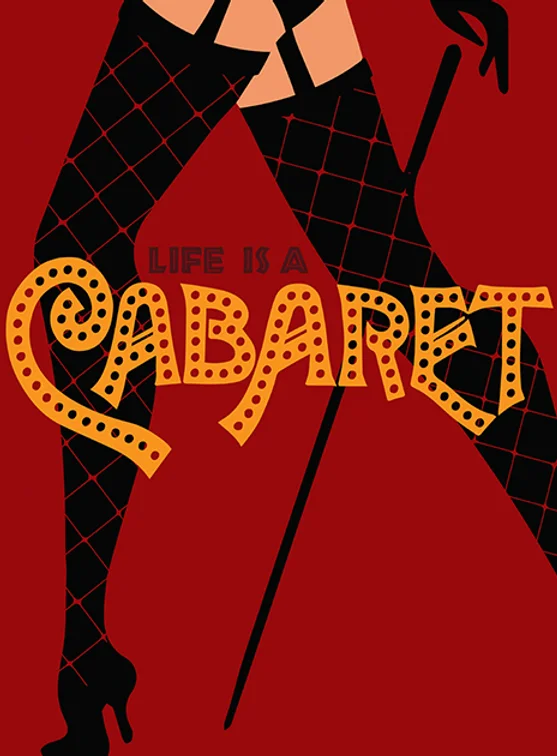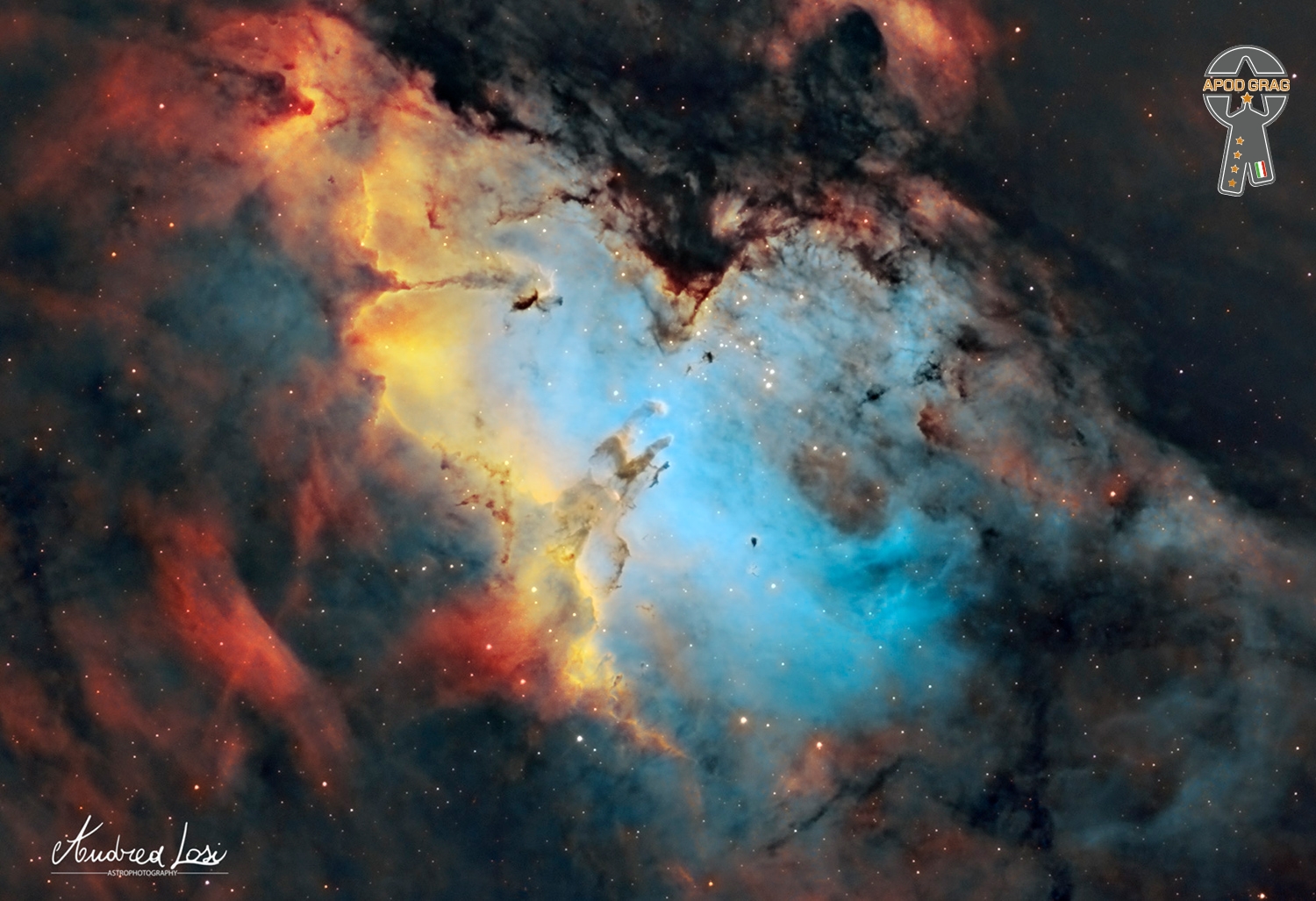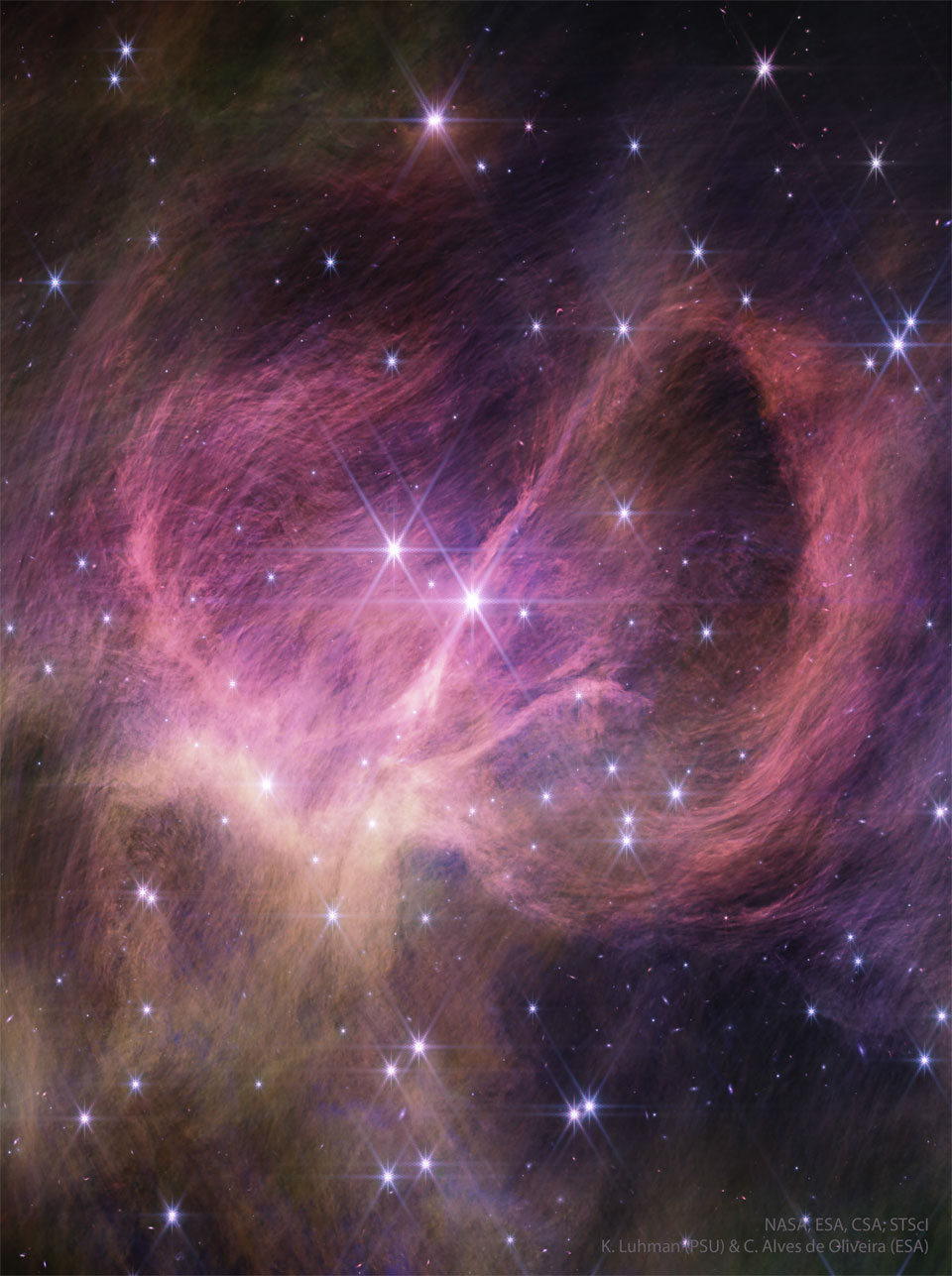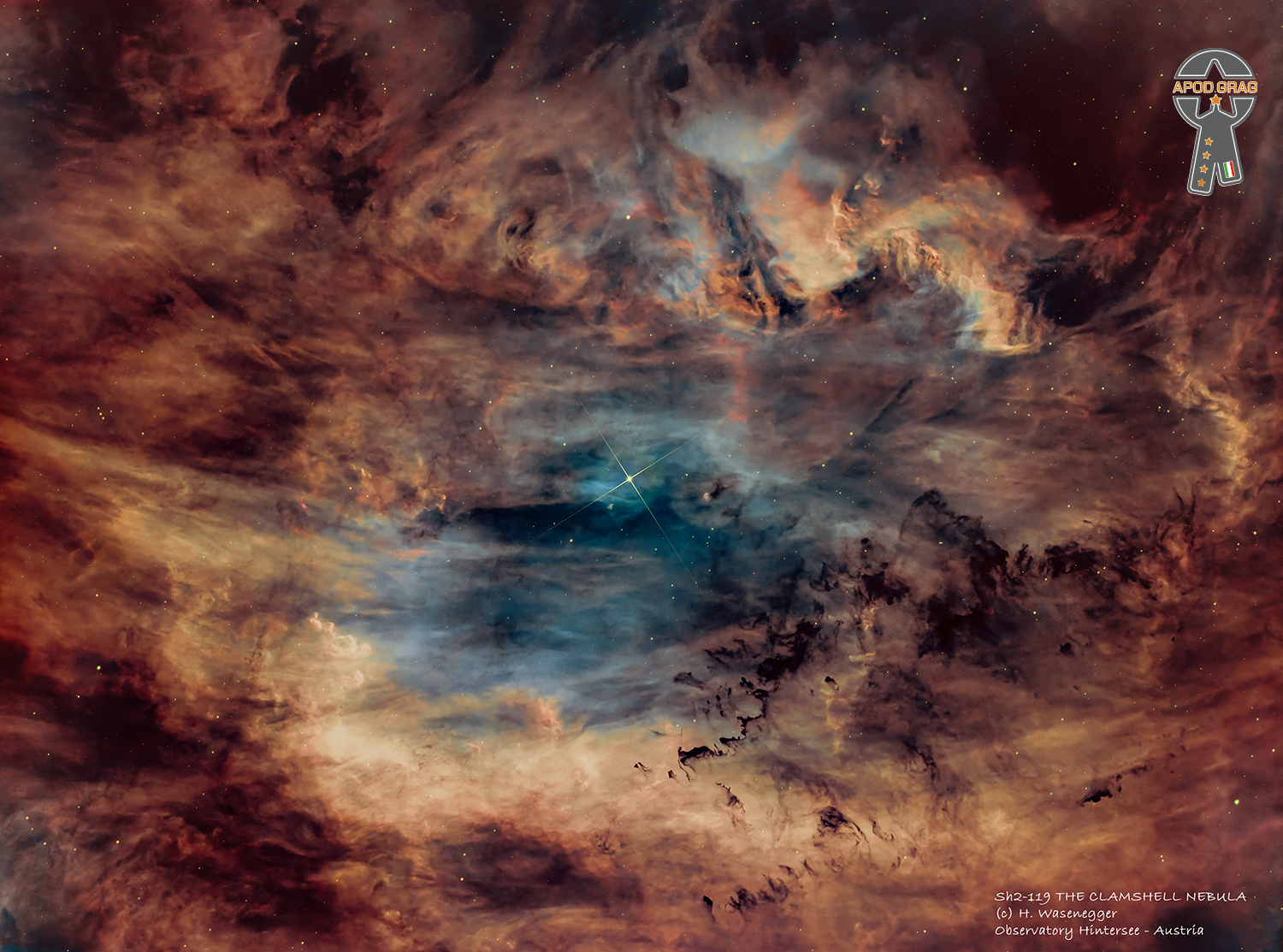Blog
Cabaret musical opening at the Mixed Blood Theater Friday February 2nd 7pm by Theatre 55. Art returning to the West Bank. Music with Shirley Mier, Lyra Olson, Jeff Ruhnke, Brian Handeland, Bebe Keith and mick laBriola!

more...
Friday 19th 2024 6pm Erev Shabbat Service music with Inbal Sharret Singer, Jayson Rodovsky, Jeff Bailey, Pete Whitman and mick laBriola.
more...
The Eagle Nebula (catalogued as Messier 16 or M16, and as NGC 6611, and also known as the Star Queen Nebula) is a young open cluster of stars in the constellation Serpens, discovered by Jean-Philippe de Cheseaux in 1745–46. Both the “Eagle” and the “Star Queen” refer to visual impressions of the dark silhouette near the center of the nebula, an area made famous as the “Pillars of Creation” imaged by the Hubble Space Telescope. The nebula contains several active star-forming gas and dust regions, including the aforementioned Pillars of Creation. The Eagle Nebula lies in the Sagittarius Arm of the Milky Way.

Janis Lyn Joplin (January 19, 1943 – October 4, 1970 Port Arthur, TX) was an American singer and songwriter. One of the most successful and widely known rock performers of her era, she was noted for her powerful mezzo-soprano vocals and “electric” stage presence.
In 1967, Joplin rose to prominence following an appearance at Monterey Pop Festival, where she was the lead singer of the then little-known San Francisco psychedelic rock band Big Brother and the Holding Company. After releasing two albums with the band, she left Big Brother to continue as a solo artist with her own backing groups, first the Kozmic Blues Band and then the Full Tilt Boogie Band. She appeared at the 1969 Woodstock festival and on the Festival Express train tour. Five singles by Joplin reached the US Billboard Hot 100, including a cover of the Kris Kristofferson song “Me and Bobby McGee“, which posthumously reached number one in March 1971.[9] Her most popular songs include her cover versions of “Piece of My Heart“, “Cry Baby“, “Down on Me“, “Ball and Chain“, “Summertime“, and her original song “Mercedes Benz“, her final recording.
Joplin died of a heroin overdose in 1970, at the age of 27, after releasing three albums (two with Big Brother and the Holding Company and one solo album). A second solo album, Pearl, was released in January 1971, just over three months after her death. It reached number one on the Billboard charts. She was posthumously inducted into the Rock and Roll Hall of Fame in 1995. Rolling Stone ranked Joplin number 46 on its 2004 list of the 100 Greatest Artists of All Time and number 28 on its 2008 list of 100 Greatest Singers of All Time. NPR dubbed Joplin as “The Queen of Rock” and named her one of the 50 Great Voices. She remains one of the top-selling musicians in the United States, with Recording Industry Association of America certifications of 18.5 million albums sold.
more...Augustus Owsley Stanley III (January 19, 1935 – March 12, 2011) was an American-Australian audio engineer and clandestine chemist. He was a key figure in the San Francisco Bay Area hippie movementduring the 1960s and played a pivotal role in the decade’s counterculture. Under the professional name Bear, he was the sound engineer for the Grateful Dead, recording many of the band’s live performances. Stanley also developed the Grateful Dead’s Wall of Sound, one of the largest mobile sound reinforcement systems ever constructed. Stanley also helped Robert Thomas design the band’s trademark skull logo.
Called the Acid King by the media, Stanley was the first known private individual to manufacture mass quantities of LSD. By his own account, between 1965 and 1967, Stanley produced at least 500 grams of LSD, amounting to a little more than five million doses.
He died in a car accident in Australia (where he had taken citizenship in 1996) on March 12, 2011.
Stanley was the scion of a political family from Kentucky. His father was a government attorney. His paternal grandfather, Augustus Owsley Stanley, a member of the United States Senate after serving as Governor of Kentucky and in the U.S. House of Representatives, campaigned against Prohibition in the 1920s.
more...Horace Parlan (January 19, 1931 – February 23, 2017) was an American pianist and composer known for working in the hard bop and post-bop styles of jazz. In addition to his work as a bandleader Parlan was known for his contributions to the Charles Mingus recordings Mingus Ah Um and Blues & Roots. He was born in Pittsburgh, Pennsylvania, United States. In his birth year, Parlan was stricken with polio, resulting in the partial crippling of his right hand. The handicap contributed to his development of a particularly “pungent” left-hand chord voicing style, while comping with highly rhythmic phrases with the right. Between 1952 and 1957, he worked in Washington, D.C., with Sonny Stitt, then spent two years with Mingus’ Jazz Workshop. In 1973, Parlan moved to Copenhagen, Denmark. He later settled in the small village of Rude in southern Zealand. In 1974, he completed a State Department tour of Africa with Hal Singer.
more...IC 348 is a young star cluster that illuminates surrounding filamentary dust. The stringy and winding dust appears pink in this recently released infrared image from the Webb Space Telescope. In visible light, this dust reflects mostly blue light, giving the surrounding material the familiar blue hue of a reflection nebula. Besides bright stars, several cool objects have been located in IC 348, visible because they glow brighter in infrared light. These objects are hypothesized to be low mass brown dwarfs. Evidence for this includes the detection of an unidentified atmospheric chemical, likely a hydrocarbon, seen previously in the atmosphere of Saturn. These objects appear to have masses slightly greater than known planets, only a few times greater than Jupiter. Together, these indicate that this young star cluster contains something noteworthy — young planet-mass brown dwarfs that float free, not orbiting any other star. This image from the NIRCam (Near-Infrared Camera) instrument on the NASA/ESA/CSA James Webb Space Telescope shows the central portion of the star cluster IC 348. Astronomers combed the cluster in search of tiny, free-floating brown dwarfs: objects too small to be stars but larger than most planets. They found three brown dwarfs that are less than eight times the mass of Jupiter. The smallest weighs just three to four times as much as Jupiter, challenging theories for star formation. The wispy curtains filling the image are interstellar material reflecting the light from the cluster’s stars — what is known as a reflection nebula. The material also includes carbon-containing molecules known as polycyclic aromatic hydrocarbons, or PAHs. The bright star closest to the centre of the frame is actually a pair of type B stars in a binary system, the most massive stars in the cluster. Winds from these stars may help sculpt the large loop seen on the right side of the field of view. [Image description: Wispy hair-like filaments of pink-purple fill the middle of the image, curving left and right on either side of the centre. On the right, the filaments form a dramatic loop that seems to extend toward the viewer. At lower left are additional yellowish filaments. Two prominent, bright stars near the centre of the image show Webb’s eight-point diffraction spikes. Dozens of fainter stars are scattered across the image.]

more...
Steven Mark Grossman (January 18, 1951 – August 13, 2020) was an American jazz fusion and hard bopsaxophonist.
Grossman was Wayne Shorter‘s replacement in Miles Davis‘s jazz-fusion band. He played with Chick Corea on the album “The Sun” in 1970, then, from 1971 to 1973, he was in Elvin Jones‘s band.
In the late 1970s, he was part of the Stone Alliance trio with percussionist Don Alias and bassist Gene Perla. The group released four albums during this period, including one featuring Brazilian trumpeter Márcio Montarroyos. The albums also feature an array of other musicians. They went on to release three live reunion albums during the 2000s.
more...David Ruffin (born Davis Eli Ruffin; January 18, 1941 – June 1, 1991 Whynot, MS) was an American soul singer and musician most famous for his work as one of the lead singers of the Temptations (1964–1968) during the group’s “Classic Five” period as it was later known. Ruffin was the lead voice on such famous songs as “My Girl” and “Ain’t Too Proud to Beg.”
Known for his unique raspy and anguished tenor vocals, Ruffin was ranked as one of the 100 Greatest Singers of All Time by Rolling Stone magazine in 2008 and again in 2023. He was inducted into the Rock and Roll Hall of Fame in 1989 for his work with the Temptations. Fellow Motown recording artist Marvin Gaye once said admiringly of Ruffin that, “I heard [in his voice] a strength my own voice lacked.”
more...Vassilis Tsitsanis (Greek: Βασίλης Τσιτσάνης 18 January 1915 – 18 January 1984) was a Greeksongwriter and bouzouki player. He became one of the leading Greek composers of his time and is widely regarded as one of the founders of modern Rebetiko and Laiko music. Tsitsanis wrote more than 500 songs and is still remembered as an extraordinary composer and bouzouki player.
Tsitsanis was born in Trikala, in Thessaly, Greece. His family came from the region of Epirus. He has been described as having been an Aromanian, and his surname Tsitsanis could indicate some connection with the Aromanians of Metsovo. He was the only figure performing rebetiko at his time coming from the Greek mainland and not from the islands. This may be the reason why he was sometimes known as “the Vlach” by his fellow musicians, although this could be due to the actually Aromanian ethnic origin of Tsitsanis (as Aromanians are known as Vlachs in Greece). It is also rumored that Stratos Pagioumtzis gave him this nickname. Tsitsanis was also nicknamed “Tsilias”.
more...Aloysius Tyrone Foster (born January 18, 1943) is an American jazz drummer. Foster’s professional career began in the mid-60s, when he played and recorded with hard bop and swing musicians including Blue Mitchell and Illinois Jacquet. Foster played jazz fusion with Miles Davis during the 70s and was one of the few people to have contact with Davis during his retirement from 1975–1980. During Davis’s retirement, Foster continued to play and record acoustic jazz with Sonny Rollins, Dexter Gordon, McCoy Tyner, Horace Silver, and other band leaders. Foster played on Miles Davis’s 1981 comeback album The Man with the Horn, and was the only musician to play in Davis’s band both before, and after, his retirement. After leaving Davis’s band in the mid-80s, Foster toured and recorded with Herbie Hancock, Sonny Rollins, Joe Henderson, and many other band leaders, primarily working in acoustic jazz settings. Foster has also released several solo albums under his own name, starting with Mixed Roots in 1978.
Foster was born in Richmond, Virginia, United States, and grew up in New York. He began playing drums at the age of 13 and made his recording debut on Blue Mitchell‘s, The Thing to Do, at age 20.
He joined Miles Davis‘s group when Jack DeJohnette left in 1972, and played with Davis until 1985. In his 1989 autobiography, Davis described the first time he heard Foster play live in 1972 at the Cellar Club in Manhattan: “He [Foster] knocked me out because he had such a groove and he would just lay it right in there. That was the kind of thing I was looking for. Al could set it up for everybody else to play off and just keep the groove going forever.”
more...It is located about 2 degrees west of the North America Nebula , or 9 degrees west of the bright star Deneb ; it appears to envelop the star 68 Cygni , of fifth magnitude . It can be observed with a medium-power amateur telescope and shows itself very well in long-exposure photographs.
Its shape appears similar to two shells that are arranged to the east and west of 68 Cygni; the eastern part is the largest. In the southern part, thin filaments and cocoons of dark nebulae are visible , which contrast strongly both with the light of the nebula and with the rich star field in the background. The distance of Sh2-119 is estimated at 2200 light years from us.

Michael Kevin Taylor (born 17 January 1949) is an English guitarist, best known as a former member of John Mayall’s Bluesbreakers (1967–1969) and the Rolling Stones (1969–1974). As a member of the Stones, he appeared on Let It Bleed (1969), Get Yer Ya-Ya’s Out! The Rolling Stones in Concert (1970), Sticky Fingers (1971), Exile on Main St. (1972), Goats Head Soup (1973) and It’s Only Rock ‘n Roll (1974).
Since leaving the Rolling Stones in December 1974, Taylor has worked with numerous other artists and released several solo albums. From November 2012 onwards he participated in the Stones’ 50th-Anniversary shows in London and Newark, and in the band’s 50 & Counting tour, which included North America, Glastonbury Festival and Hyde Park in 2013. He was ranked 37th in Rolling Stone magazine’s 2011 list of the 100 greatest guitarists of all time. Guns N’ Roses guitarist Slash states that Taylor had the biggest influence on him.
more...Eartha Mae Kitt (born Keith; January 17, 1927 – December 25, 2008) was an American singer and actress known for her highly distinctive singing style and her 1953 recordings of “C’est si bon” and the Christmas novelty song “Santa Baby“.
Kitt began her career in 1942 and appeared in the 1945 original Broadway theatre production of the musical Carib Song. In the early 1950s, she had six US Top 30 entries, including “Uska Dara” and “I Want to Be Evil“. Her other recordings include the UK Top 10 song “Under the Bridges of Paris” (1954), “Just an Old Fashioned Girl” (1956) and “Where Is My Man” (1983). Orson Welles once called her the “most exciting woman in the world”. She starred as Catwoman in the third and final season of the television series Batman in 1967.
In 1968, her career in the U.S. deteriorated after she made anti-Vietnam War statements at a White Houseluncheon. Ten years later, Kitt made a successful return to Broadway in the 1978 original production of the musical Timbuktu!, for which she received the first of her two Tony Award nominations. Her second was for the 2000 original production of the musical The Wild Party. Kitt wrote three autobiographies.
Kitt found a new generation of fans through her roles in the Disney films The Emperor’s New Groove(2000), in which she voiced the villainous Yzma, and Holes (2003). She reprised the role as Yzma in the direct-to-video sequel Kronk’s New Groove (2005), as well as the animated series The Emperor’s New School (2006–2008). Her work on the latter earned her two Daytime Emmy Awards. She posthumously won a third Emmy in 2010 for her guest performance on Wonder Pets!
more...More Posts
- Wilbur Ware Day
- World Music with Tsedenia Gebremarkos
- Daily Roots with the Impact All Stars
- The Cosmos with NGC 2080
- Buddy Holly Day
- Little Milton Day
- Sonny Rollins Day
- World Music with Paco de Lucia
- Daily Roots with David Madden and Augustus Pablo
- The Cosmos with NGC 6960
- Charles Moffett
- Jimmy Reed Day
- World Music with Shashmaqam
- Daily Roots with Junior Brown
- The Cosmos with NGC 3628
- Buddy Miles Day
- John Cage Day
- Sunnyland Slim Day
- World Music with Maayan Band
- Daily Roots with Jerry Harris